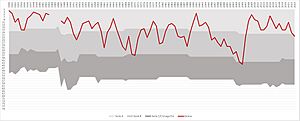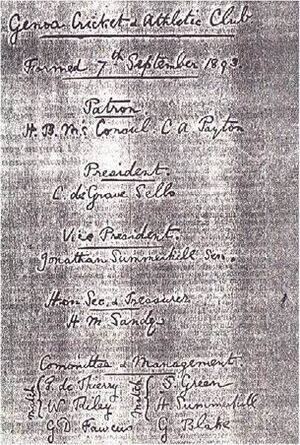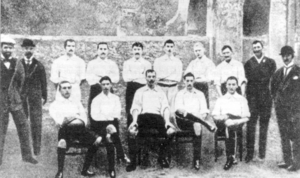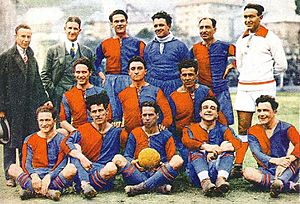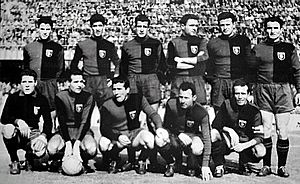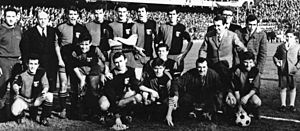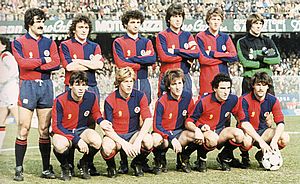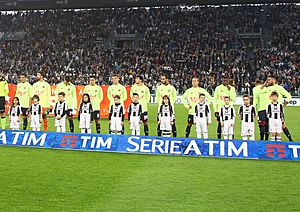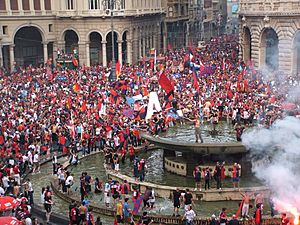Genoa CFC facts for kids
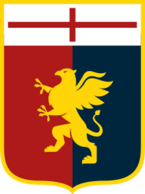 |
||
| Full name | Genoa Cricket and Football Club S.p.A. | |
|---|---|---|
| Nickname(s) | Il Grifone (The Griffin) I Rossoblù (The Red and Blues) Il Vecchio Balordo (The Old Fool) |
|
| Founded | 7 September 1893 | |
| Ground | Stadio Luigi Ferraris, Genoa | |
| Capacity | 33,205 | |
| Owner | Dan Șucu | |
| President | Dan Șucu | |
| Head coach | Patrick Vieira | |
| League | Serie A | |
| 2018–19 | Serie A, 17th of 20 | |
|
|
||
Genoa Cricket and Football Club is a professional football team from Genoa, Liguria, Italy. They play in Serie A, which is the top football league in Italy.
Genoa was started in 1893, making it the oldest existing football team in Italy. The club has won the Italian Championship nine times. Their first win was in Italy's very first national championship in 1898. Their most recent championship win was after the 1923–24 season. They have also won one Coppa Italia title. Overall, Genoa is the fourth most successful Italian club when it comes to winning championships.
The team is nicknamed Il Grifone (The Griffin). They have played their home games at the Stadio Luigi Ferraris since 1911. They share this stadium with their local rivals, Sampdoria. The game between these two teams is called the Derby della Lanterna, and it was first played in 1946.
In 2011, Genoa was recognized as a "historical sporting heritage" club. In 2013, the club joined the "Club of Pioneers". This is a special group of the world's oldest football clubs, including teams like Sheffield F.C. and Recreativo de Huelva.
Contents
The Start of Genoa CFC
The club began on September 7, 1893, as Genoa Cricket & Athletic Club. At first, it focused mainly on athletics and cricket. Association football was not their main sport yet. The club was created to represent England in other countries. Because of this, their first uniforms were white, just like the England national team.
Initially, only British people could join the club. Genoa's activities took place in the Campasso area of the city. On April 10, 1897, the football part of the club became the most important. This happened thanks to James Richardson Spensley. At that time, Genoa's football section was one of the oldest in Italian football. Only four other clubs, all in Turin, had been started before them. After this change, Italians were allowed to join the club. They also found a new home ground called Ponte Carrega.
Genoa played its first friendly match at home against a mixed team from Internazionale Torino and F.B.C. Torinese. Genoa lost that game 1–0. Soon after, Genoa won its first game away from home, beating UPS Alessandria 2–0. They also played friendly games against British sailors.
Becoming Champions: Early Wins
Football in Italy grew bigger with the creation of the Italian Football Federation and the Italian Football Championship. Genoa played in the very first Italian Championship in 1898. This tournament was held at Velodrome Humbert I in Turin. On May 8, Genoa won their first official game, beating Ginnastica Torino 2–1. Later that same day, they won the first championship by defeating Internazionale Torino 3–1 after extra-time.
Genoa came back for the next season with some changes. The club's name was changed to Genoa Cricket & Football Club, removing "Athletic." Their uniform colors also changed to white and blue vertical stripes, known as biancoblù. Genoa won their second title in a one-day tournament on April 16, 1899. They beat Internazionale Torino 3–1 again. On their way to winning their third championship in a row in 1900, they also beat local rivals Sampierdarenese 7–0. This was a huge win that no other team in the league would beat until 1910. They won the final by beating F.B.C. Torinese 3–1.
In 1901, the club's uniform changed again. Genoa started wearing their famous red and navy half-and-half shirts, becoming known as the rossoblù. These colors are still used today. After finishing second to Milan Cricket and Football Club one season, Genoa got back on track in 1902 and won their fourth title.
Juventus became a strong competitor from 1903 onwards. For two seasons in a row, Genoa beat Juventus in the national final. Genoa also became the first Italian football team to play an international match. They visited France on April 27, 1903, to play FVC Nice and won 3–0. Besides winning the Italian championship in 1904, Genoa's reserve team also won the first ever II Categoria league season. This was like an early version of Serie B, the second level of Italian football.
From 1905, Genoa started to lose its top position in the Italian championship. Other clubs like Juventus, Milan, and Pro Vercelli became stronger. In 1908, the FIGC made a rule against using foreign players. Genoa, which had many English players, disagreed and left the official competitions that year. The next season, the rule was changed, and Genoa rebuilt its team with players like Luigi Ferraris and some from Switzerland. The team also got a new home stadium in the Marassi area of Genoa. It opened on January 22, 1911, and could hold 25,000 fans.
The Garbutt Era and War Challenges
When the Italy national football team was formed, Genoa players like Renzo De Vecchi, Edoardo Mariani, and Enrico Sardi were called up to play. Renzo De Vecchi was even the team captain for a while. The club hired an English coach named William Garbutt to help the team improve. Garbutt was the first professional manager in Italy. He was known for being very lively and always smoking his tobacco pipe. Players called him "Mister," and since then, Italians have used this term for coaches.
By 1914–15, Genoa was again the best club in Northern Italy. They won the final round of the Northern section. However, the national final could not be played that year because of World War I. The winners of the Southern Italian section could not be decided, so Genoa had no team to play against. Genoa was awarded the title in 1919 after the war ended. This was their first championship in eleven seasons.
The war was very hard on Genoa. Players like Luigi Ferraris, Adolfo Gnecco, Carlo Marassi, Alberto Sussone, and Claudio Casanova died while serving in the military. The club's founder, James Richardson Spensley, was also killed in Germany.
In the early 1920s, Genoa remained a strong team in the Northern section. Garbutt led Genoa to win the championship in 1922–23. They beat Lazio 6–1 over two games in the final. The next season, Genoa beat Bologna in the Northern finals. This win was a bit controversial because of some trouble during the second game in Bologna. The game was stopped, and the FIGC gave Genoa a 2–0 victory. In the national final that season, Genoa beat Savoia 4–1 over two games. This was their ninth and, so far, last Italian championship.
After Genoa's championship win in 1923–24, the scudetto patch was introduced. This means that after a club wins an Italian league championship, they can wear a shield-shaped patch on their shirt with the colors of the Italian flag. For the rest of the 1920s, the club's best finish was second place in the 1927–28 season. They finished behind Torino, with striker Felice Levratto scoring 20 goals.
Changes and Challenges
In 1928, the club was forced to change its name to Genova 1893 Circolo del Calcio by the fascist government. This was because the name "Genoa" sounded too British. The club played in an early European competition called the Mitropa Cup. They lost in the quarter-finals to Rapid Vienna. Back home, they finished second in the league in the 1929–30 season, behind Ambrosiana. This was their last second-place finish in the top league to date.
Genoa's league performance was very up and down in the early 1930s. In the 1933–34 season, Genova was relegated for the first time to Serie B, the second Italian league. Luckily, they quickly bounced back under manager Vittorio Faroppa. They won promotion by finishing first in their group, ahead of Novara. In 1936, Juan Culiolo became the ambitious chairman of the club. In 1936–37, they finished 6th and also won the Coppa Italia. They beat Roma 1–0 with a goal from Mario Torti.
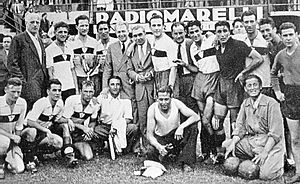
The next season, Genova finished in third place. This was a very close season, with winners Ambrosiana-Inter finishing only three points ahead. That summer, Italy won the 1938 FIFA World Cup. Three Genova players, Sergio Bertoni, Mario Genta, and Mario Perazzolo, were part of that winning team. The club ended the decade strongly, staying in the top five of the Italian football league.
World War II greatly affected Italian football. In 1945, the club decided to change its name back to Genoa Cricket and Foot-Ball Club. This was the name they used in the very early days of the Italian championship. After the war, the club was still popular with fans. Former club members like Ottavio Barbieri and William Garbutt returned as managers. Genoa also got a new rival, Sampdoria. Sampdoria was formed in 1946 by combining two other teams and shared the Stadio Luigi Ferraris with Genoa.
After the War: Ups and Downs
After World War II, Genoa found it harder to finish at the top of Serie A. Through the rest of the 1940s, the club usually finished in the middle of the league table. The 1948–49 season saw some big wins for Genoa. They beat Inter 4–1, the famous Grande Torino team 3–0, and Padova 7–1.
The 1950s started poorly for the club. They bought Argentine player Mario Boyé from Boca Juniors, but he only stayed one season. The club was relegated after finishing last. However, after two seasons, they returned to Serie A by winning Serie B, ahead of Legnano. Ragnar Nikolay Larsen was an important player for the club during this time. Genoa continued to finish in the middle of the table for the rest of the decade.
Despite being relegated in 1959–60 and then promoted back to Serie A in 1961–62, Genoa had some good cup success in the early 1960s. The club won the Coppa delle Alpi in 1962. This was the first time this competition was played between club teams instead of national teams. Genoa won the final at home, beating French club Grenoble Foot 38 1–0 with a goal from Nizza. Genoa won the same competition again two years later. The final was held in Bern, Switzerland. Genoa defeated Catania 2–0, with both goals from Giampaolo Piaceri, to win the trophy.
The celebrations did not last long. The year after their last cup win, they were relegated to Serie B again. This time, they stayed in the second tier of Italian football for much longer. The club was not stable and changed managers every season. Genoa even experienced its first relegation to Serie C in 1970. The club also faced financial problems and had several changes in ownership.
Mixed Results and European Adventures
Throughout the 1970s, Genoa mostly played in the second tier. Under manager Arturo Silvestri, the club returned to Serie A for the 1973–74 season, but they were relegated right back down. When Il Grifone returned to Serie A a couple of seasons later, the team included players like Roberto Rosato, Bruno Conti, and a young Roberto Pruzzo. This time, they stayed in the top division for two seasons before being relegated in 1977–78. This relegation was especially tough because the team above them, Fiorentina, stayed up by just one goal difference. The two teams had played each other on the last day of the season, and it ended in a 0–0 draw.
The relegation was bad for the club in several ways. They lost some of their best players, like Roberto Pruzzo, who moved to Roma and became very successful there. After a few seasons in the middle of Serie B, Genoa earned promotion during the 1981 season under manager Luigi Simoni. The club finished second, only behind AC Milan, who had been relegated the previous season due to a betting scandal.
With Simoni still as manager, Genoa managed to stay in Serie A for their return season. They finished just one point ahead of the relegated AC Milan. In a dramatic last game of the season, Genoa was losing 2–1 to Napoli with five minutes left. Then, in the 85th minute, Mario Faccenda scored the goal that gave Genoa the point they needed. This moment started a lasting friendship between the fans of the two clubs.
A couple of seasons later, in 1983–84, Genoa was not as lucky. Even though they beat champions Juventus on the last day, the club was relegated. They finished with the same number of points as Lazio, but Lazio stayed up because they had better results in games against Genoa.
European Adventures and Challenges
Calabrese businessman Aldo Spinelli bought the club in 1985. Even without Simoni as manager, Genoa was finishing in the top half of Serie B. After a dip in form in 1987–88, Genoa focused again and earned promotion back to Serie A in 1988–89. They finished as champions, ahead of Bari.
Genoa, with experienced coach Osvaldo Bagnoli and talented players like Carlos Aguilera and Tomáš Skuhravý, had a great 1990–91 season. They finished fourth, staying undefeated at home for the entire season. They won games against all the big teams, including Juventus, Inter, Milan, Roma, Lazio, Fiorentina, Napoli, and their local rivals Sampdoria.
Because of this success, the club entered the UEFA Cup in the 1991–92 season. Genoa had a good run, reaching the semi-finals before being knocked out by Ajax, who won the competition that season. Notably, Genoa beat Liverpool twice in the quarter-finals, becoming the first Italian team to beat the Reds at Anfield.
Unfortunately, this success was followed by a difficult period after Osvaldo Bagnoli left. The club struggled to replace key players as they got older or moved to other teams. Famous Genoa players during this time included Gianluca Signorini, Carlos Aguilera, Stefano Eranio, Roberto Onorati, and John van 't Ship.
Chairman Spinelli had a different way of running the club. He saw Genoa as a business that should make money for him. He was happy to sell good players for a lot of money and then buy less expensive replacements. For example, he sold Uruguayan striker Carlos Aguilera and replaced him with Kazuyoshi Miura from Japan. In the same season as their UEFA Cup run, Genoa finished just one spot above the relegation zone. In the following seasons, Genoa stayed in the lower half of the table.
During the 1994–95 season, Genoa was almost relegated. They finished with the same points as Padova, which meant they had to play a special game in Florence to decide who would be relegated. The game was tied 1–1 and went to a penalty shoot-out. Genoa lost the shoot-out 5–4.
While back in Serie B, the club had another international cup success. They won the last ever Anglo-Italian Cup in 1996, beating Port Vale 5–2. Gennaro Ruotolo scored three goals in that game. Chairman Spinelli sold Genoa in 1997. The late 1990s and early 2000s were very tough for the club. They had many manager changes, financial problems, and little hope of getting promoted. From 1997 to 2003, Genoa had three different owners and four different chairmen. Then, Enrico Preziosi, a businessman who owned a toy company, took over.
Recent Times
Enrico Preziosi became chairman in 2003. Genoa should have been relegated to Serie C1 after a bad season, but the football federation controversially decided to expand Serie B to 24 teams, which saved Genoa. Things started to improve for Genoa; they won Serie B in 2004–05. However, there were claims that the club had fixed a match on the last day of the season against Venezia. Genoa won that game 3–2, which helped them win the league. But the Italian Football Federation decided to place Genoa at the bottom of the league and relegate them to Serie C1 with a three-point penalty on July 27, 2005.
For their season in Serie C1 in 2005–06, Genoa started with a six-point penalty from the previous season. After leading for much of the season, they finished second. They then entered the play-offs and beat Monza 2–1 over two games to get promoted back to Serie B. During the summer break, Gian Piero Gasperini became the new manager. He helped the club get promoted during the 2006–07 season. This was confirmed on the last day of the season when they drew 0–0 with Napoli. Both clubs were happily promoted back into Serie A.
The 2007–08 season was Genoa's first Serie A championship in 12 years. They finished in a good tenth place, right after the top Italian football clubs.
Chairman Preziosi carefully strengthened the team by buying new players and selling some others for good prices. For example, he sold striker Marco Borriello to AC Milan for a lot of money. Genoa's goal for the 2008–09 season was to qualify for the UEFA Cup. They achieved this after a strong season, finishing fifth in Serie A. They even beat big teams like Juventus, Roma, and Milan. They also won both Genoa derby matches against Sampdoria. Diego Milito was one of the top scorers in the league that season.
Genoa later lost Milito and midfielder Thiago Motta to Internazionale, but they brought in striker Hernán Crespo. However, things did not go as planned. The team had many injuries and was knocked out early from the Europa League and Coppa Italia. They finished ninth in Serie A in 2010.
In the 2010–11 season, Genoa struggled in the middle of the league. After some poor results, chairman Preziosi fired coach Gian Piero Gasperini, who had led the team since the 2007–08 season. Davide Ballardini became the new manager. The team managed to stay in the top half of the league and won two derby matches against Sampdoria in December and May.
The 2011–12 and 2012–13 seasons saw Genoa finish in 17th place both times. This was just one spot away from being relegated to Serie B.
In the 2014–15 season, Genoa finished sixth and was set to qualify for the UEFA Europa League. However, they were not given a UEFA license because they submitted paperwork late. Also, the Stadio Luigi Ferraris was not ready for UEFA competitions. The spot was then given to 7th-placed Sampdoria.
This hurt Genoa's progress. They finished eleventh in the 2015–16 season. In 2016–17, Genoa avoided relegation, finishing 16th. They finished in the middle of the table again in the 2017–18 season. In the 2018–19 season, Genoa avoided relegation from Serie A. They had the same points as Empoli, but Empoli went down because Genoa had a better record in games against them.
In the 2021–22 season, Genoa finished 19th in the league and was relegated after fifteen years in the top division. In the 2022–23 season, the club finished second in Serie B. This meant they were promoted back to Serie A after just one season. In the 2023–24 season, Genoa Football Club stayed in Serie A and did not face relegation. The club continues to play in Italy's top football league, showing its strength and determination.
Players
Current Squad
|
|
Players on Loan
|
|
Other Players Under Contract
|
|
Retired Jersey Numbers
- 6 –
 Gianluca Signorini, a defender who played from 1988–95.
Gianluca Signorini, a defender who played from 1988–95. - 7 –
 Marco Rossi, a midfielder who played from 2003–04 and 2005–13.
Marco Rossi, a midfielder who played from 2003–04 and 2005–13. - 12 – This number is for the fans of Gradinata Nord, who are seen as "the twelfth man" on the team.
Club Colors, Badge, and Nicknames
Since Genoa was started by British people, its first uniforms were the same colors as the England national football team. Later, in 1899, the kit changed to white and blue stripes. The blue color was chosen to represent the sea, as Genoa is a port city. In 1901, the club finally decided on their most famous red and blue half-and-half shirt. This gave them the nickname rossoblù (red and blues).
One of Genoa's nicknames is Il Grifone, which means "the griffin". This comes from the coat of arms of the city of Genoa. The city's coat of arms has two golden griffins on either side of the Saint George's Cross. The cross is also on the flag of Genoa and reminds people of the club's English founders. Saint George was also the patron saint of the old Republic of Genoa. The actual club badge of Genoa Cricket and Football Club is very similar to the city's coat of arms, but it also includes the club's red and blue colors.
Fans and Rivalries
Most of Genoa CFC's fans live in Liguria, but they are also popular in Piedmont and the Aosta Valley. Because Genoa is a city with a strong seafaring history, and many Genoese people moved to other countries, Genoa's popularity spread far beyond Italy. Fans started clubs in places like Buenos Aires, Amsterdam, Tokyo, Toronto, New York, San Francisco, Barcelona, and Iceland.
Genoa's biggest and oldest rivalry is with the club they share a stadium with, Sampdoria. The games between these two teams are called the Derby della Lanterna ("Derby of the Lantern"), named after the famous Lighthouse of Genoa. Genoa's fans also strongly dislike AC Milan.
On the other hand, Genoa fans have a long-standing friendship with Napoli fans. This friendship started back in 1982. On the last day of the 2006–07 season, Genoa and Napoli drew 0–0. This result meant both clubs were promoted back to Serie A. Genoa fans held up banners saying "Benvenuto fratello napoletano," which means "Welcome, Neapolitan brother." The two groups of fans celebrated together in a friendly way.
The good relationship with Roma fans, which grew after striker Roberto Pruzzo moved there in 1979, has become less strong in recent years. Also, a strong friendship between Genoa and Torino fans has perhaps ended. This friendship began after a player exchange in 1964 and the sad death of Gigi Meroni in 1967. In the 2008–09 season, Torino needed points to avoid relegation. Torino fans expected Genoa to be "friendly" and let them win. But Genoa was fighting for a spot in the UEFA Champions League and beat Torino, which sealed Torino's relegation.
Club Ownership
777 Partners
On September 23, 2021, it was announced that Genoa had been bought by 777 Partners. This is a private investment company from the US. The team was bought for about $175 million. Even though Genoa was relegated to Serie B in their first season under 777 Partners, they quickly returned to Serie A the very next year.
Cricket Team
In its early days, the club was involved in many sports, but it later focused only on football. In 2007, a group of club supporters started a cricket section. This team now plays as Genoa Cricket Club 1893 in Serie A of the Italian cricket league.
Genoa in European Competitions
UEFA Cup/Europa League Matches
| Season | Round | Opponent | Home Score | Away Score | Total Score |
|---|---|---|---|---|---|
| 1991–92 | First round | 3–1 | 0–1 | 3–2 | |
| Second round | 3–1 | 2–2 | 5–3 | ||
| Third round | 1–0 | 1–0 | 2–0 | ||
| Quarter-finals | 2–0 | 2–1 | 4–1 | ||
| Semi-finals | 2–3 | 1–1 | 3–4 | ||
| 2009–10 | |||||
| Play-off round | 3–1 | 1–1 | 4–2 | ||
| Group B | 1–2 | 2–3 | 3rd | ||
| 3–2 | 0–3 | ||||
| 2–0 | 0–0 |
Club Achievements
National League Titles
- Italian Football Championship / Northern League / Serie A:
- Winners (9): 1898, 1899, 1900, 1902, 1903, 1904, 1914–15, 1922–23, 1923–24
- Serie B:
- Winners (6): 1934–35, 1952–53, 1961–62, 1972–73, 1975–76, 1988–89
- Serie C / Serie C1 (North):
- Winners (1): 1970–71
Cup Wins
- Coppa Italia: 1
- Winners: 1936–37
- Runners-up: 1939–40
Other Trophies
- Coppa delle Alpi: 2
- Winners: 1962, 1964
- Anglo-Italian Cup: 1
- Winners: 1996
Youth Team Titles
- Campionato Nazionale Primavera: 1
- Winners: 2009–10
- Coppa Italia Primavera: 1
-
- Winners: 2008–09
- Primavera Super Cup: 2
- Winners: 2009, 2010
- Torneo di Viareggio: 2
-
- Winners: 1965, 2007
- Campionato Nazionale Under-18: 2
- Winners: 2020–21, 2023–24
- Campionato Nazionale Under-17:
- Runners-up: 2020–21
- Campionato Nazionale giovanile: 2
- Winners: 1939, 1942
League History
| Series | Years | Last Season | Promotions | Relegations |
|---|---|---|---|---|
| A | 57 | 2024–25 | – | |
| B | 34 | 2022–23 | ||
| C | 2 | 2005–06 | never | |
| 93 years of professional football in Italy | ||||
| Founding member of the Football League's First Division in 1921 | ||||
The total from 1897–98 includes 105 seasons at a national level from the start of the Italian football league. This includes 27 seasons of Prima Categoria and Prima Divisione (from 1898 to 1922, the Italian Football Championship was called Prima Categoria). Seasons include Prima Categoria 1907–1908, where Genoa did not enter the tournament.
See also
 In Spanish: Genoa Cricket & Football Club para niños
In Spanish: Genoa Cricket & Football Club para niños
- Successful Teams in Italian Football
- Club of Pioneers
- Genoa CFC Women
- Scudetto of the Pistols


